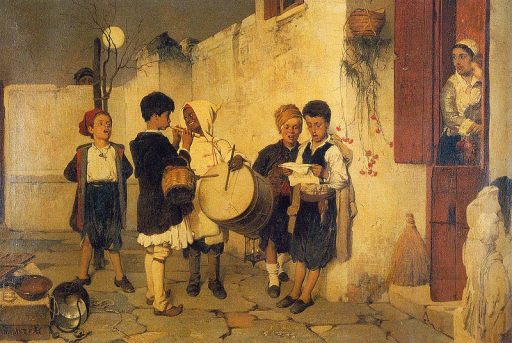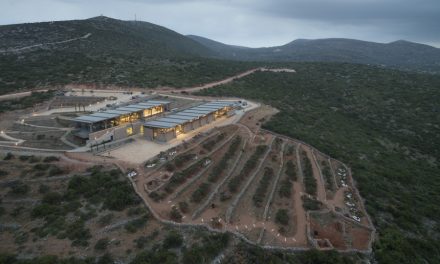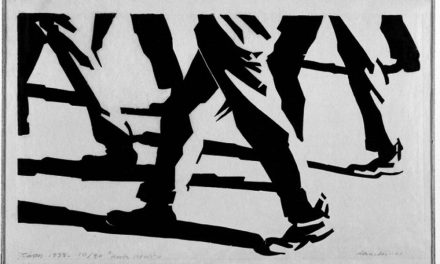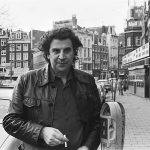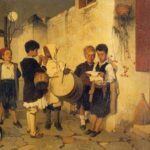Christmas, the happiest time of the year is just around the corner! Throughout this festive season, celebrated across the world, millions of people spend time with loved ones, exchange gifts, taste special treats and practice local traditions.
In Greece, Christmas is primarily a religious holiday, strongly influenced by the Greek Orthodox tradition, as well as by local customs. It is also a great opportunity family and friends to get together and celebrate. It is a joyful season and its proximity to New Year’s Eve makes it even brighter. If Epiphany (Theophania) is also added, the whole festive period runs from December 24th to January 7th. So, let’s get to know some special traditions that make Christmas so special in Greece!

The Christmas Carols (kalanda) is one of the oldest customs in Greece. Tradition calls for an early wake up on the Eves of Christmas, New Year and Epiphany. Children, in groups of two or more, holding triangles (small traditional percussion instruments), go door-to-door, knocking and asking “shall we sing them?”. If the landlord’s response is positive, the kids sing the Christmas carols and wish for health and joy for the upcoming year. In the old times, children would be offered holiday sweets and pastries, but today they are usually given some money.
The Christmas boat is the traditional seasonal decoration in Greece. The Christmas tree, which is the most ubiquitous one nowadays, wasn’t brought to our country until 1833, when it was introduced by the state’s first king, of a Bavarian royal line. Until that time, a decorated miniature boat (karavaki in Greek) was the centerpiece of the season. Children would also carry it while caroling as a symbol of Christmas while their companions would hold the triangle as they sang. Today, depending on the region, it can still be seen in town and city squares or as ornaments for the Christmas tree or Christmas lights arrangements. The Christmas boat tradition is closely connected to the maritime tradition of the country. Many Greeks working in the shipping industry were away during Christmas time, and the tiny boat would symbolize the family’s prayers for them. Today, many families decorating their homes with both trees and boats.
The Christmas Mass is another important tradition, still followed by many families in Greece. It bears special significance especially for those who have observed the 40-day Christmas fast, since after this service that they may finally break the fast and enjoy a festive meal.

The Christmas treats traditional top Greece are among the most popular staples of the season. Among the most popular ones we find the “kourabiedes”, a special kind of almond butter cookie dusted with icing sugar,“melomakarona” a delicious soft cookie soaked in honey and sprinkled with walnuts and “diples”, pieces of dough deep-fried until they take a golden color, and afterwards drizzled with honey and sprinkled with cinnamon and nuts.
On Christmas day, the whole family gathers around the table for a sumptuous meal. The main dish is usually roasted pork or lamb although nowadays turkey stuffed with chestnuts and dried fruits is gaining ground.
“Christopsomo” (Christ’s bread), is also served. Considered as an offering to Jesus Christ, it is a special kind of round shaped bread prepared the previous day just for the occasion. Usually made with nuts, raisins, cloves and honey, it features the cross of Christ as well as various decorations. It is believed to bring health, good luck and happiness to the household. Depending on the skill and time invested it can be turned into a true work of art!

New Year’s Eve is probably the most joyful event of the season. It is always celebrated in good company with family and friends, traditionally around another festive meal. Contrary to most traditions of the western world, gifts are not usually exchanged on Christmas. Most Greeks do that on New Year ’s Day, which is also the name day of St Basil, the Greek equivalent of Santa Klaus/Father Christmas. Gifts are usually placed under the Christmas tree until the last day of the year.

“Vassilopita” is the traditional cake of New Year’s Eve. It is a sweet cake that is cut in a special way. The first slice is for Christ, the second for Our Lady, the third for St. Basil, then for the household, the head of the family, and so on to all other family members. Inside the cake there is a hidden coin. The one that finds it is considered to have a lucky and prosperous year ahead. On the morning of New Year’s Day, a pomegranate, symbol of fertility and happiness, is often broken at the step of each house’s front door. The red arils, spread across the doorstep, symbolize happiness and good fortune for the family, for the year ahead.
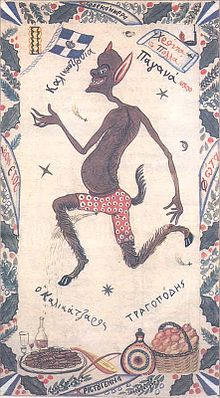
The Kallikantzaroi are, according to Greek folklore, mischievous spirits, malicious creatures living under the surface of the Earth. Their purpose all year long is to saw down the tree of life which is holding up the world. When Christmas comes around and their work is almost done they come up to the surface to bring trouble to mortals for the next 12 days. On Epiphany, however, when the priests sprinkle holy water everywhere, they are forced to go back underground, only to discover that the tree of life has regenerated thanks to the holy water, and they have to start over for another year.
Theophania (January 6th) marks the end of the festive season. The baptism of Christ is celebrated with the blessing of the waters. A cross is thrown by the priest into the sea or another body of water, and believers dive into the ice-cold waters to retrieve it. The one that brings it back to the priest is rewarded with a special blessing.
Read also via Greek News Agenda: The Greek New Year’s tradition of the vasilopita; Greek and Roman origins of Christmas traditions; Theophania: The Greek Orthodox feast of Epiphany; Arts in Greece | Nikephoros Lytras, the Artist behind Greek Christmas’ Most Celebrated Painting
DT (Intro Photo Nikephoros Lytras, Carols, 1872 Private collection)
TAGS: HERITAGE | TRADITIONS

